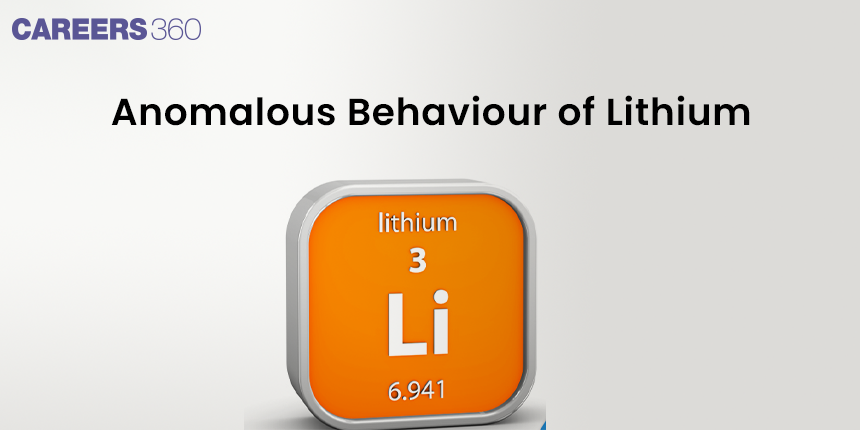Anomalous Behaviour of Lithium
Lithium, the third element in the periodic table and the lightest metal is unique among alkali metals in a lot of remarkable ways. The high reactivity and electrochemical potential of lithium are well recognized. In some physical and chemical properties, lithium is significantly different from its heavier equivalents in Group 1 because of its small atomic and ionic size, high charge density, and distinct electronic configuration. Among the many amazing anomalous behaviors that lithium displays is its diagonal interaction with the Group 2 element magnesium.

Features that are similar to those of other alkali metals but are not typically observed, such as covalent character in compounds and covalent character in compounds. Moreover, lithium has higher melting, boiling, and hardness points than potassium and sodium, which are its group neighbors. These differences highlight how crucial it is to understand lithium's unusual behavior to fully realize its promise for a variety of technical improvements, including the development of improved ceramics, lightweight alloys, and rechargeable batteries.
Also read -
Anomalous Behaviour of Lithium:
The anomalous behavior of lithium is due to the
1. Exceptionally small size of its atom and ion
2. High polarising power.
As a result, there is increased covalent character of lithium compounds which is responsible for their solubility in organic solvents. Further, lithium shows a diagonal relationship to magnesium which has been discussed subsequently.
Points of Difference between Lithium and other Alkali Metals
- Lithium is much harder. Its m.p. and b.p. are higher than the other alkali metals.
- Lithium is the least reactive but the strongest reducing agent among all the alkali metals. On combustion in air, it forms mainly monoxide, Li2O, and nitride, Li3N, unlike other alkali metals.
- LiCl is deliquescent and crystallizes as a hydrate, LiCl.2H2O whereas other alkali metal chlorides do not form hydrates.
- Lithium hydrogen carbonate is not obtained in the solid form while all other elements form solid hydrogen carbonates.
- Lithium unlike other alkali metals forms no ethynide in reaction with ethyne.
- Lithium nitrate when heated gives lithium oxide, Li2O, whereas other alkali metal nitrates decompose to give the corresponding nitrite.
- LiF and Li2O are comparatively much less soluble in water than the corresponding compounds of other alkali metals.
Points of Similarities between Lithium and Magnesium
- Both lithium and magnesium are harder and lighter than other elements in the respective groups.
- Lithium and magnesium react slowly with water. Their oxides and hydroxides are much less soluble and their hydroxides decompose on heating.
- The oxides, Li2O and MgO do not combine with excess oxygen to give any superoxide.
- The carbonates of lithium and magnesium decompose easily on heating to form oxides and CO2.
- Both LiCl and MgCl2 are soluble in ethanol.
- Both LiCl and MgCl2 are deliquescent and crystallize from aqueous solution as hydrates.
Recommended topic video on(Anomalous Behaviour of lithium)
Some Solved Examples
Q.1 Which of the following compounds is formed when Li is exposed to air?
1)Li4N+
2)Li2N
3)Li3N
4)All of these
Solution:
As we learned,
Action of air on Lithium (anomaly)
Lithium reacts with N2 as well other alkali metals do not react with N2
$6 \mathrm{Li}(\mathrm{s})+\mathrm{N}_2(g) \rightarrow 2 \mathrm{Li}_3 N(s)$
Li reacts with N2 present in the air and forms its nitride, Li3N
Hence, the answer is the option (3).
Q.2 Which of the following is the strongest reducing in nature?
1) Li
2) K
3) Na
4) Rb
Solution:
As we learned,
The greater reducing power of lithium is due to its large heat of hydration which is due to its smaller size and high charge density.
Hence, the answer is the option (1).
Also check-
Conclusion
Among the alkali metals, lithium, the third element and lightest metal in the periodic table, stands out for its unusual chemical as well as physical properties. Its high charge density, distinct electronic configuration, and small atomic and ionic size all contribute to its unusual behavior when compared to its Group 1 counterpart. These variations show up as greater melting, boiling, and hardness points, as well as a diagonal relationship with magnesium and the capacity to create covalent compounds.
Due to its high reactivity and electrochemical potential, lithium is a great material for energy storage systems, especially when it comes to the creation of lithium-ion batteries. Its special qualities also hold great potential for improvements in chemistry and materials research, including the development of lighter alloys and improved ceramics. To fully utilize lithium in a variety of technological disciplines, one needs to understand the peculiar behavior of this material. Our ability to investigate and utilize these unique qualities will help us to propel innovations that result in more productive and successful uses in materials engineering, energy storage, and other fields.
Frequently Asked Questions (FAQs)